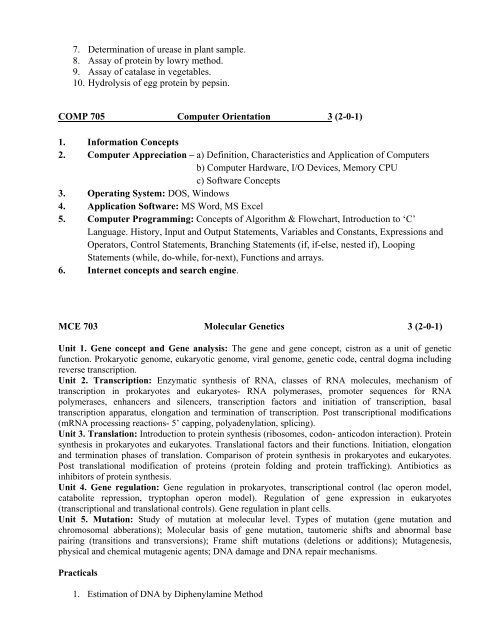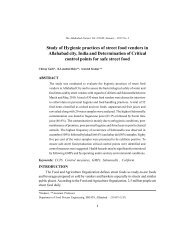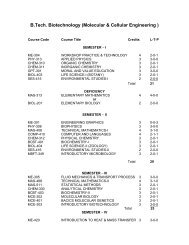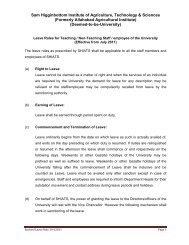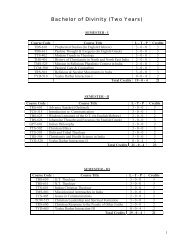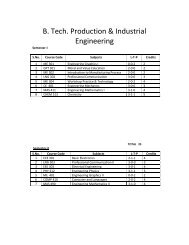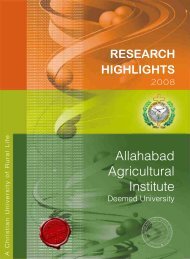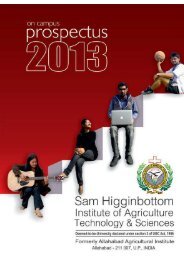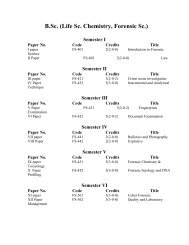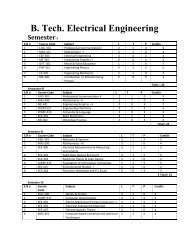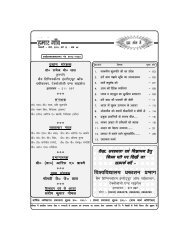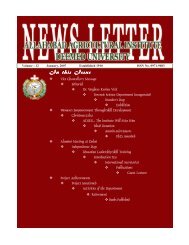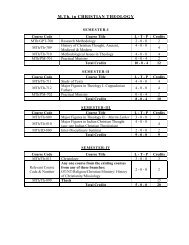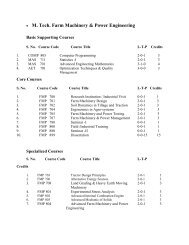M. Sc. BIOCHEMISTRY - Shiats.edu.in
M. Sc. BIOCHEMISTRY - Shiats.edu.in
M. Sc. BIOCHEMISTRY - Shiats.edu.in
You also want an ePaper? Increase the reach of your titles
YUMPU automatically turns print PDFs into web optimized ePapers that Google loves.
7. Determ<strong>in</strong>ation of urease <strong>in</strong> plant sample.8. Assay of prote<strong>in</strong> by lowry method.9. Assay of catalase <strong>in</strong> vegetables.10. Hydrolysis of egg prote<strong>in</strong> by peps<strong>in</strong>.COMP 705 Computer Orientation 3 (2-0-1)1. Information Concepts2. Computer Appreciation – a) Def<strong>in</strong>ition, Characteristics and Application of Computersb) Computer Hardware, I/O Devices, Memory CPUc) Software Concepts3. Operat<strong>in</strong>g System: DOS, W<strong>in</strong>dows4. Application Software: MS Word, MS Excel5. Computer Programm<strong>in</strong>g: Concepts of Algorithm & Flowchart, Introduction to ‘C’Language. History, Input and Output Statements, Variables and Constants, Expressions andOperators, Control Statements, Branch<strong>in</strong>g Statements (if, if-else, nested if), Loop<strong>in</strong>gStatements (while, do-while, for-next), Functions and arrays.6. Internet concepts and search eng<strong>in</strong>e.MCE 703 Molecular Genetics 3 (2-0-1)Unit 1. Gene concept and Gene analysis: The gene and gene concept, cistron as a unit of geneticfunction. Prokaryotic genome, eukaryotic genome, viral genome, genetic code, central dogma <strong>in</strong>clud<strong>in</strong>greverse transcription.Unit 2. Transcription: Enzymatic synthesis of RNA, classes of RNA molecules, mechanism oftranscription <strong>in</strong> prokaryotes and eukaryotes- RNA polymerases, promoter sequences for RNApolymerases, enhancers and silencers, transcription factors and <strong>in</strong>itiation of transcription, basaltranscription apparatus, elongation and term<strong>in</strong>ation of transcription. Post transcriptional modifications(mRNA process<strong>in</strong>g reactions- 5’ capp<strong>in</strong>g, polyadenylation, splic<strong>in</strong>g).Unit 3. Translation: Introduction to prote<strong>in</strong> synthesis (ribosomes, codon- anticodon <strong>in</strong>teraction). Prote<strong>in</strong>synthesis <strong>in</strong> prokaryotes and eukaryotes. Translational factors and their functions. Initiation, elongationand term<strong>in</strong>ation phases of translation. Comparison of prote<strong>in</strong> synthesis <strong>in</strong> prokaryotes and eukaryotes.Post translational modification of prote<strong>in</strong>s (prote<strong>in</strong> fold<strong>in</strong>g and prote<strong>in</strong> traffick<strong>in</strong>g). Antibiotics as<strong>in</strong>hibitors of prote<strong>in</strong> synthesis.Unit 4. Gene regulation: Gene regulation <strong>in</strong> prokaryotes, transcriptional control (lac operon model,catabolite repression, tryptophan operon model). Regulation of gene expression <strong>in</strong> eukaryotes(transcriptional and translational controls). Gene regulation <strong>in</strong> plant cells.Unit 5. Mutation: Study of mutation at molecular level. Types of mutation (gene mutation andchromosomal abberations); Molecular basis of gene mutation, tautomeric shifts and abnormal basepair<strong>in</strong>g (transitions and transversions); Frame shift mutations (deletions or additions); Mutagenesis,physical and chemical mutagenic agents; DNA damage and DNA repair mechanisms.Practicals1. Estimation of DNA by Diphenylam<strong>in</strong>e Method


